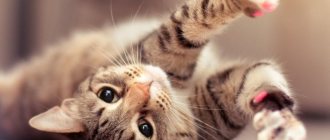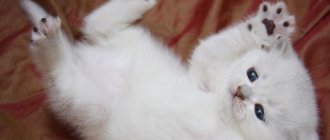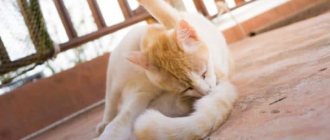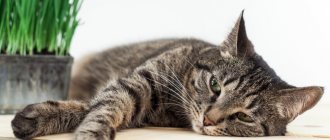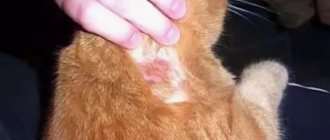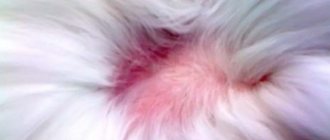When you see your cat fall to the ground and roll onto its back, your pet's posture can tell you something. Sometimes this is accompanied by rubbing the head on the floor while meowing. Your cat may be itching a lot or just wanting a good exercise, but this movement is often a positive signal for your cat. Rolling over usually signals that the cat feels secure and may want your attention.
Safety and security
A cat doesn't roll over onto its back if it doesn't feel safe. In fact, the cat rolls over onto its back in its most relaxed state. Think of it as cat zen mode. If a cat rolls over in front of you, this is a good sign. This is your cat's way of saying, "I trust you." Exposing the belly and/or sensitive parts is a very vulnerable moment for your cat and gives you both an opportunity to bond.
Communication style
For all animals, behavioral reactions and display of postures are an effective way of communicating with relatives and warning signs for ill-wishers. Representatives of the cat family are very graceful and anatomical, which, combined with a highly developed psyche, makes their body language as informative as speech for humans.
Read also: Why Hitler needed Antarctica
Cat looking for attention
Consider the time, place and circumstances under which your cat might roll onto its back. For example, if your cat rolls over in front of you every morning as you get ready for the day, it's a sign that she needs attention. Spend some time with your cat if you see him rolling on your back, your legs, or the floor.
Giving your cat this kind of attention "pays" the cat to roll - it is a positive reinforcement of the cat's behavior. This way, your cat will repeat the rolling motion again the next time more attention is needed. Cats love routine, so once you've established a pattern, rolling becomes a calming ritual.
Why does a cat roll in the dust?
It has been noticed more than once that in warm summer weather cats love to roll around outside in the dry dust. Domestic cats are regularly caught in the fact that when they enter the entrance, the first thing they do is begin to lie on the dusty concrete floor. Looking at their behavior, one can only be perplexed, since these animals generally have a passion for cleanliness, but certainly not for dust. One might assume that such wallowing gives them pleasure, but after this the cat will have to spend quite a lot of time to wash off all the dirt, and even if it is lying around for pleasure, then why not do it in a clean place? Agree that this is not very similar to ordinary self-massage or gymnastics. Then maybe they do this so that their fur coat will absorb the smells of the street?
Cat Behavior Marking
Rolling on the ground can spread cat odor. Since cats primarily communicate through the scent of someone or something, they use their scent glands on their cheeks, paws, and sides to give them a personal scent. This behavior is observed in both domestic and large cats.
When your cat rubs its head and cheeks on the floor, it can leave its scent marks on the house and on your feet. This tells the other cats that they were there, took their place and have already marked you (so the other cats need to retreat). Marking is used as a way to keep potential enemies or rivals away.
Many cats instinctively want to mark their territory through rubbing and scratching. However, if your cat is marking its territory with urine, you will need to teach it to stop.
Marks territory
When marking territory or their owner, cats roll on their backs, leaving marks on objects that have an unfamiliar smell on them. Purrs often do this when their owners return home and bring other people's scents on their clothes. In this case, the pet can roll on its back on clothes lying, for example, in a laundry basket, while grumbling and as if trampling something with a foreign smell with its paws.
We recommend reading: Immunomodulators: mechanism of action and clinical application
How can you tell when a cat is marking its territory in this way? At the same time, she will definitely rub her muzzle on the floor, because it is on it that special glands are located that leave the pet’s individual smell. In this way, the cat seems to inform its relatives that this territory or the owner belongs only to it alone and that it will never want to part with its “property” without a fight.
When marking territory or an object, a cat can release its claws and, as it were, rub them on the floor or object on which they want to leave scent marks.
Mating and catnip
If you've ever given your cat catnip, you may have noticed this rolling behavior. Catnip herb usually incites a strong reaction in cats. Its active compound nepetalactone is a powerful aroma that awakens a cat's sexual desires. This is what makes them roll on the ground after inhaling.
You will also find that many cats roll around and rub against objects during heat or after mating. This is probably due to hormones and ovulation. Any frantic movements could also mean that your cat is trying to get rid of the cat's scent before moving on to another cat.
Rolling on the floor as an expression of playfulness
Of particular note is the tendency of cats to roll around near their owner’s feet. As a rule, this happens when the owner is busy with some business. In this case, the cat wants to attract his attention and hints that the owner should drop everything and pet her or play with her. In other words, this is a manifestation of playfulness and desire for contact. When the owner is constantly busy with something, and the cat is forced to spend all the time alone, she is sometimes forced to deliberately attract the attention of her owner. In this case, you should really take a break from your affairs and devote at least a minute or two to your pet. However, you should warn in advance that cats are crafty creatures and, exposing its belly to the owner and inviting the owner to pat it, the cat will immediately grab his hand with its claws.
Cats are not as submissive as dogs
Many dogs roll over onto their back as a sign of respect or submission, unlike cats. When cats roll over, it is usually an invitation for attention rather than submission. If you have another animal in the house, such as a dog, your cat may roll back when the other pet isn't around to let you know it needs some love.
Never assume that your cat is asking for a tummy rub like dogs do when they roll over. Otherwise, your hand may be grabbed and forced into submission. Most cats love scratches behind the ears, so it's best to start there.
Dust as a means of camouflage
Cats living in the wild are forced to provide their own food, and their prey also has some intelligence. But besides this, she also has a fairly developed sense of smell, thanks to which she can sense the presence or approach of a hunter. To get rid of this, on the one hand, the cat constantly licks itself to minimize its natural aromas, and on the other hand, it tries to mask them by rolling out in the dust. Even if the smell of a cat seeps through the smell of dust, it will be little distinguishable from the smell of ordinary cat tracks left on a dusty path, which can dull the vigilance of potential prey, which cats successfully use. And although in urban environments there is no need for camouflage, the habit turns out to be second nature not only for humans, and cats continue to wallow in the dust, as if they were still living somewhere in arid Africa and tracking down local small rodents.
Limitless possibilities
There may be other reasons why your cat rolls on the ground. Because cats have a higher body temperature, they are more likely to sunbathe or sleep near a heater. Because of this, cats can easily experience this sensation and need to cool down. This includes drinking plenty of water, resting in cool places, and rubbing yourself on cool floors. Your cat can also protect its digestive system by rolling around in the dirt, coating its fur with bacteria and ingesting it by licking its fur. Whatever your cat is doing, there's probably a good reason for it.
Health problems
Discomfort experienced by a pet can also cause riding on its back. Often, a cat tries to relieve itching in certain areas of its body in this way. After all, she cannot reach with her paws everywhere: for example, on the pet’s back there are areas that the purr will never be able to reach on its own.
The secret is revealed: 4 reasons why cats love boxes
Then the cat can either ask the owner to scratch its back, holding it up for stroking, or lie down on the floor and roll from side to side, which also helps it relieve itchy skin.
If your pet experiences discomfort due to itching, she may suffer from skin diseases such as allergies, itchy scabies or, for example, flea dermatitis. If a cat rolls irritably on its back too often and for a long time, and its entire appearance expresses dissatisfaction or even suffering, the owner should carefully examine his pet. And if you find bald patches, scratches, weeping areas, dandruff or redness on her skin, you must contact a veterinary clinic for a diagnosis and treatment.
Sleeping on your back: normal or pathological?
The instincts, behavior and habits of cats are in many ways similar to human ones. This applies not only to reactions and needs inherent in nature, but also to banal physical states: relaxation, tension, etc. During rest, a person can lie on his back, stomach, side, or in the fetal position. This is often due to the level of fatigue, mood, or a banal habit.
In their dreams, cats encounter different emotionally charged episodes.
Curious! Scientists conducted a number of experiments studying animals during sleep, in particular cats were experimental subjects. It turned out that they, like people, are no strangers to emotional dreams. Moreover, it was possible to decipher their contents. Mostly these are episodes of hunting, exploring the area, irritation and even fear.
They say that a cat sleeping on its back sees only good dreams.
Human and cat rest are similar in that during this time both are capable of experiencing happiness. For cats, one of the indicators of this condition is sleeping on their back. This body position is absolutely normal. There is no need to worry about the health of a kitten seen lying on its back with half-closed eyes.
Euphoria from aromas
Some smells cause a state of euphoria in cats. As soon as the molecules of the coveted aromas reach the mucous membrane of the olfactory tract, the mustachioed striped animals begin to run from corner to corner, roll on the floor, purr loudly and rub their skin against the scent mark.
From the plant world, two species are most attractive to cats:
- Alcohol infusion of valerian or its tablet form. Widely used as a cardiac and sedative in medical pharmacology. However, valerian has a stimulating effect on cats because it contains organic acids that resemble the smell of pheromones. The attractive smell causes the cat to lick the medicine or chew the stems of the plant, which is why valerian is called the “cat drug.” At the same time, the effect on the hormonal system and psyche is so strong that some animals go on a rampage, receiving a psychotropic effect with hallucinations, drooling and convulsions. Trying to get to the coveted drug, they can turn over or break a bottle of alcohol solution and get a burn to the mucous membrane and severe poisoning. After a prolonged attack, inappropriate behavior can persist for several days, manifested by increased excitability, fear of loud sounds, apathy and refusal to eat and drink. It is noteworthy that about 70% of the population of mature cats are sensitive to valerian, while in females this figure is halved. The intoxicating effect does not apply to kittens.
- Catnip, or catnip. It is completely harmless to cats and is even sold in pet stores in the form of sachets or powder. If your favorite ball or toy mouse is sprinkled with catnip, the cat will play for at least a quarter of an hour, after which the happy cat will fall asleep next to it. Felinologists recommend using the properties of the plant as a natural antidepressant by placing a sachet with catnip in a carrier cage with a cat when moving or to a new place.
Oops, there's something there
The most common reason that a cat sits on its butt and goes on its way is an unsuccessful bowel movement. A furry cat may have waste products stuck to the fur around his anus, and he may try to get them off by rubbing them against the carpet. At the same time, in any animal, feces can get stuck in the anus for a variety of reasons, and the cat, looking around and assessing the size of the “problem,” may decide that it is wiser not to lick the butt, but to first wipe it on the floor.
In this case, there is no need to be particularly concerned, although it is worth observing the animal. If this happens frequently, consider trimming your cat's fur around the anus if feces are getting stuck there, or choosing a higher fiber food if they get stuck at the exit. In addition, she should always have access to water, which is necessary for easy bowel movements.
What does a cat symbolize?
If a cat appears in the house, signs and superstitions immediately gain momentum. Royal nature is considered an indispensable companion of witches in the world of mysticism. Graceful, cunning and quick-witted - they personify some of the behavioral traits of their owners. For some people, cats symbolize peace and comfort. For others, it is the personification of selfishness and manipulation. For others, cats are a symbol of wealth and financial well-being. One way or another, most owners equate truly magical powers to their pets, since these animals quite often prove their healing abilities, putting in order both the physical health and moral balance of their owners.
What is important to remember
Despite the positive aspects, spending time with your pet at night is fraught with a number of troubles. According to a study by somnologists, sleep quality deteriorates among those who sleep with pets. The productivity of rest time decreases, because cats are nocturnal animals by nature and are unlikely to lie quietly with people until the morning.
The largest beetles in the world
Other adverse effects include:
- Feeling of discomfort. They don’t think about the comfort of the owners; they lie down the way they like. In the middle of the night they disturb you by purring and trampling on family members. They even bite suddenly if the sleeping behavior seems threatening.
- Too little sleep. Cats tend to wake up at 4 - 5 o'clock in the morning. First they will want food and water, and then they will want to play. To get what they want, they will wake up the household. It is clear that people will not like a sudden awakening.
- Poor hygiene. Although cats are clean and wash themselves constantly, the risk of dangerous parasites like toxopalasma remains. There should be no helminths or fleas; this requires giving the animals special medications.
- The appearance of allergies. According to research, wool does not have a negative effect on the body. Only substances that are secreted by internal secretion.
To prevent the animal from interfering with the night's rest, it is important to provide the pet with a comfortable place, away from the hustle and bustle. A suitable option is to provide a personal sleeping item
For example, a smooth pillow, bed, house or heated mat.
At what age does a cat start asking for a cat?
Puberty of a furry pet ends with the first heat. For everyone, this happens at its own time, but, as a rule, before the age of one.
Veterinarians note that a cat may first begin to raise her rear end and desire to reproduce between 6 and 10 months of age.
That’s when it’s hard for the owner not to understand what’s going on. With the first heat, there comes a period when this behavior will occur regularly. There are a number of signs that make it clear that a person wants a cat for the first time.
shutterstock
- She screams shrilly. This is where natural instincts come into play, and you can’t go against nature. Wild cats call their partners with loud, heart-rending cries, indicating that they are ready to mate.
- Leaves marks everywhere. Estrus is always accompanied by discharge, which involuntarily remains where the pet has been. This is also inherent in nature to attract a male.
- There is a decrease in appetite or its complete absence only in conjunction with the above symptoms.
- Poses characteristic of mating. The cat raises her hindquarters and withdraws her tail, calling for a male.
- A pet asking for a cat becomes especially affectionate, can follow on the heels of the owner, rub against his legs, while raising her tail. However, all cats have different personalities, and this is reflected in their behavior during heat; your cute pet can become wild and aggressive.
Cat cycle length
When asked about the duration of the period when she asks the cat, characteristically raising her hind end, not a single veterinarian can answer accurately.
Many owners do not want to let their cat outside or bring in a male for mating. Everyone knows what consequences this leads to - several months of the whims of a pregnant cat, childbirth and caring for kittens. In addition, she can go for walks often: every 3-4 weeks. If such prospects do not inspire optimism, then sterilization measures should be taken or drugs that extinguish sexual instincts should be given.
Sterilization
Medicine does not stand still in “animal” matters. Here contraceptive methods come to the rescue of owners, allowing a cat to mate without bearing offspring; some owners choose them. Sterilization is the best option if you don’t want to watch her lift her hindquarters, you don’t need kittens and the pet’s periodic heart-rending screams.
shutterstock
Although a neutered cat will raise her hind end, this is an instinct. Previously, it was believed that it was better to let her give birth for the first time before surgery. But veterinarians have a different opinion: sterilize before birth.
It is believed that there may be a hormonal change that may affect the cat's health.
Medicines
If you are against surgery, but listening to the cat's cries and seeing how the back end lifts is tiring, contact your pharmacists. In “cat” pharmacies you will find a number of drugs that will calm your pet’s sexual instincts. However, they should not be used frequently; consult your doctor regarding dosage and frequency.
The question remains: why does a cat lift his hindquarters? There is only one answer to it - strong sexual arousal. He can lean on his hind legs and lower himself onto his front legs. Try giving him sedatives as well.
Why does a cat need a tail?
A cat's tail is a genetically determined extension of the spine. The average length of this section of the spinal column is 25-28 cm and consists of 19-23 vertebrae. And this is about 10% of the total number of bones in the animal’s skeleton.
For example, the tail of a human ancestor disappeared during the process of evolution as completely unnecessary about 1.2 million years ago. Felines are an even more ancient species than humans. If a cat has a tail, then for some reason the animal needs it.
Balancer, rudder and parachute...
For a long time, a cat's tail was considered an important means of balancing. He was credited with the ability of cats:
- walking gracefully along a thin branch or the top of a fence;
- straighten the body when falling from a height;
- turn sharply when pursuing prey.
Debunking myths. These misconceptions were dispelled back in the 60th year of the last century by Arthur MacDonald, a Canadian physicist and Nobel laureate. Subsequently, his findings were confirmed by scientists from various fields of science and even veterinarians. Manxes and Cymrics, which do not naturally have tails, or short-tailed bobtails, are not inferior to their long-tailed counterparts in agility, grace and other characteristics of motor activity.
For example, Susan Nuffer, a breeder of Manx cats, assures that the absence of a tail does not affect the life and communication of her pets. By the way, Susan is the record holder for the number of cats living in her house. She has 11 favorites with whom the woman lives in perfect harmony.
What about tailless ones? In them, nature compensated for the loss of the tail with longer hind legs and powerful muscles. Cats maintain balance by moving their torso, head, and paws.
This means that the tail is not so useless in the process of movement, no matter what physicists say.
You understand me
Renowned animal behaviorist Michael Fox believes that the main function of the tail is to aid in communication.
Tailless cats have to compensate for the lack of an important tool by other means - voice, facial expressions, postures. This does not deprive furry purrs of the opportunity to express their emotions
The communication of tailless cats can be compared to the communication of deaf and dumb cats - it is possible, but it has its own characteristics and problems.
Ancient signs about cats
Previously, these animals were credited with magical abilities. People believed that a cat's eyes could see things that were inaccessible to the human eye. Many signs associated with cats have been invented. Some of them:
- In order for a pet to take root, it cannot be accepted as a gift, it is necessary to give a symbolic “ransom”
- In order for a brownie to accept a new tenant, you need to choose a kitten with hair the same color as the owner’s hair
- For unmarried girls, a cat is more suitable so that it attracts a man to the house
- In order for the family to have prosperity and happiness, you need to choose a kitten with a short tail
- to quickly add a new addition to the family, you need to take a pregnant cat into your home and allow her to give birth in comfort and warmth
- adult cats do not take root well, so it is better to take a small kitten
- to attract good luck you need to take a stray animal from the street
Why is the cat allowed into the house first?
Since ancient times, owners have entered a new home after their furry pet. This sign is considered the most famous about cats in the house. It is based on the belief in the cat's ability to sense and neutralize negative energy. If the cat was the first to enter the apartment, the family will live in prosperity and happiness. The animal will eliminate the negativity remaining from the previous residents and appease the brownie.
Why might a cat leave the house?
If a pet leaves the apartment of his own free will, he takes with him impending troubles. If the cat is lost, a child will soon be born in the family. If a pet escapes from the home of a seriously ill person, it will soon die. Sometimes a cat runs away from a house in which a lot of negativity has accumulated. The animal is unable to cope with it.
Often the reason for voluntary departure is not mystical reasons, but the bad attitude of the owners. If a person is indifferent, does not show love and care, the animal feels unnecessary and leaves the house.
About the guests
- If the cat washes itself while sitting on the windowsill or at the front door, visitors will come to the house.
- The pet washes its head behind the right ear - guests will come with good intentions.
- If it rubs behind the left, it means a visit from enemies.
- Assumptions about visitors can be made based on the temperature of the animal’s paws. Warm limbs mean a friend will come, cold limbs mean an enemy.
- If a cat is affectionate with a visiting guest, he is reliable. An animal does not approach a hypocrite.
Signs about death
If the cat lies down on the table, someone in the house will die. The animal foreshadows the death of a seriously ill person if she lies by his bed and does not leave. The cat marked the clothes of the sick person - the illness will soon pass. The cat lies down at the feet of the patient - to recovery. If the animal moves away, the person will die. A cat goes to sleep next to its owner's head - foretells imminent death. The long, loud meow of a cat foreshadows the death of a household member.
Road signs
A common belief about a pet crossing the road says that there will be no path. It's better to turn back or take another road. In England, there is another sign - if someone going on a trip hears meowing, it is better to postpone the trip.
When you go on the road, you can ask your pet to protect the house from thieves and uninvited visitors. If the animal purrs in response to affection, everything will turn out well. A loud meow warns that you cannot leave your home.
You can tell by your pet's behavior how successful the trip will be. If it fits in the suitcase, the trip will be successful. The animal throws things away - you need to stay home.
Cat and material well-being
There are several beliefs associated with furry pets that help attract money. One of the superstitions tells how to get an irredeemable coin from evil spirits with the help of a black cat. It is believed that it always returns to the owner and helps to get rich. Together with the cat at midnight they go out to the intersection of roads and turn to the west. The pet is pinched several times to make it meow. A spirit will come asking you to sell the animal. The person must agree and ask for a ruble. This coin will remain with the person forever and will mark the beginning of wealth.
The Chinese believe that a cat in the house attracts material well-being. But you can’t adopt a stray cat. Otherwise, financial success will leave a person.
A cat that caresses its owner attracts expensive gifts and profit. To gain wealth and good luck, you need to pet a gray pet with white paws on the waxing Moon.
Cats and weather
The animal fell asleep, curled up in a ball and covering its nose with its paw, in anticipation of the imminent onset of frost. The pet goes to bed close to a heat source - when it gets cold. The cat scratches the furniture and wallpaper - it will be windy outside. The animal spreads its paws in a dream - to warm weather. If your pet washes itself with its paw behind its ears, it will rain. The loud meowing of a cat on a ship foreshadows a storm. If the pet spreads its tail, a storm will begin.
Why you shouldn't hurt cats
If a pet is treated poorly, it becomes aggressive and begins to take revenge on its ungrateful owners. Some cats turn into downtrodden, frightened animals. If you drag your pet by the tail, he will walk past the tray. You cannot beat cats for educational purposes if they damage furniture or mark your apartment. It is better to use substances with an unpleasant, repellent odor for this purpose.
| Signs associated with killing or harming a cat | Interpretation |
| Kill a cat | Imprisonment, 7 years of misfortune. She will be the first to meet her owner after death in the world of the dead |
| Drown a kitten | Poverty, loneliness, drowned people in the family for 7 generations |
| Hit a cat with a car | Luck will run out for 7 years, a serious accident will happen soon, loved ones will betray you |
| The cat died | To the appearance of a rival |
| If the cat is injured | Failures in personal life due to men |
| Newlyweds hit a cat | To divorce |
